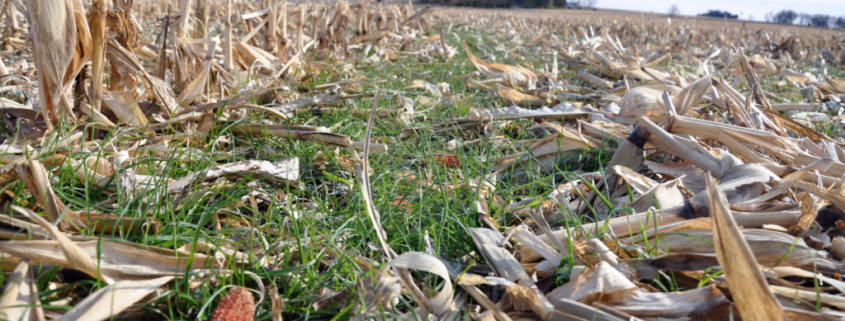USDA UPDATES OPTIONS FOR COVER CROP TERMINATION
July 2019
Cover crops are a critical tool that farmers can use to improve soil health, reduce erosion, retain moisture, and suppress weeds. Especially as farmers are up against devastating floods, drought, and unpredictable weather and pressures, cover crop adoption is an essential practice to build resilient systems and mitigate risk. Despite these clear benefits for risk mitigation, however, USDA cover crop termination guidelines have presented major roadblocks for farmers concerned about maintaining their eligibility for federal crop insurance. In response to a 2018 Farm Bill directive, that roadblock was largely removed by USDA last week.
The National Sustainable Agriculture Coalition (NSAC) worked with our members and partners to reduce cover crop termination barriers through the 2018 Farm Bill. Key provisions that we backed and were included in the final bill have now been incorporated into updated cover crop termination guidelines from USDA. NSAC applauds USDA for quickly moving forward to ensure these changes were in place for the 2020 crop year and for incorporating our feedback as they worked to update the guidelines. We hope they will move quickly again to make several further improvements on the cover crop rules, and then proceed without delay to addressing the larger issue of making all conservation practices acceptable within the federal crop insurance program.
Cover Crop Termination Guidelines – Background
The cover crop termination guidelines were established several years ago, the product of an interagency workgroup including the Natural Resources Conservation Service (NRCS), the Risk Management Agency (RMA), and the Farm Service Agency (FSA), all of which are now housed under USDA’s Farm Production and Conservation (FPAC) mission area. The process of establishing the guidelines involved input from experts, stakeholders, and farmers with firsthand experience adopting cover crops on their land.
Cover crop termination means a practice that “historically and under reasonable circumstances results in the termination of a cover crop,” and is completed before the planting of a cash crop. The purpose of the guidelines was to ensure that termination is timed and conducted in such a way as to ensure that winter cover crops are terminated properly, so they do not act as weeds in crop production, slowing soil drying and warming in the spring. The post below details the major changes included in the updated cover crop termination guidelines, including what it means for farmers in the 2020 crop year and beyond.
Cover Crops as Good Farming Practices
Prior to the passage of the 2018 Farm Bill, NRCS cover crop termination guidelines had to be strictly followed in order to retain federal crop insurance eligibility, or a deviation from the guidelines had to be approved in advance. For many would-be cover crop adopters, this additional step was a major barrier and discouraged them from incorporating cover crops into their insured management systems out of fear of potentially jeopardizing their coverage and not wanting to jump through additional hoops.
The updated guidelines now clarify that rather than having to go through the approval process in advance, the cash crop can be insured at the time of planting, and cover crop management practices will be reviewed under the normal RMA rules for Good Farming Practice (GFP) determinations, which is similar to how other management decisions are reviewed for crop insurance purposes (e.g. fertilizer application, seeding rates, pest management, etc.).
The GFP process kicks in whenever there is a question by the insurer as to whether a producer is entitled to an indemnity payment when they have a loss. A farmer’s indemnity payment can be reduced based on the amount of the loss that is attributed to their failure to employ GFP. The theory behind that is that a well-defined standard for the production of a crop reduces the moral hazard associated with federally subsidized crop insurance. A farmer who does not care for their crops up to the standard, cannot receive their full indemnity.
Recognizing cover crop practices as GFP follows the directive from the 2018 Farm Bill. NSAC urged RMA to ensure that the GFP process replaced the previous rigid pre-set termination rules, and we are pleased that the new plan reflects this shift.
Flexibility to Ensure Locally Adaptive Management and Provide Maximum Assurance
The updated guidelines make clear that they are not intended to function as a substitute for locally adaptive management for cover crop termination timing, but rather serve as but one option available to producers. It is essential cover crop termination decisions can be flexible and site-specific, in order to optimize water use efficiency, erosion control, soil health improvement, weed and pest control, habitat for beneficial organisms, nutrient cycling, and water quality improvement.
The guidelines will now serve as one option available to farmers, rather than as a mandated prescription. As a recognized nationally applicable agricultural expert resource, they provide an additional level of comfort for producers that want to have the up-front assurance that their cover cropping management decisions will be considered a GFP. However, RMA also recognizes that farmers may be implementing innovative cover cropping systems that fall outside of the guidelines, and thus additional options are being provided for those farmers seeking up-front assurance. Farmers can opt to utilize any one of the following three options:
- Pre-approved termination options from NRCS (“NRCS Cover Crop Termination Guidelines”)
- Pre-approved cover crop management options based on published expert advice applicable to the crop and the region
- Requesting an exception to the guidelines based on a written letter of support from a research, extension, or other expert
In the case of option #1, the guidance document provides information by zone regarding when the cover crop should be terminated in relation to the planting of the following crop. There is also additional guidance available regarding no-till systems, fall seeded cover crops, exceptionally dry or wet seasons, as well as cover used as herbaceous wind barriers or nurse crops.
Under the new policy, however, there is no need for farmers to make use of one of those three pre-approval options. Pre-approval is an option, not a requirement. As mentioned above, cover crop management, including termination, can now be handled through the normal Good Farming Practice process in the same manner as all other agronomic practices. Should an insurance company at claim time take steps to suggest a lack of GFP, the producer can obtain a letter of support from two local experts supporting their cover crop management and termination practice. Treating cover crops under GFP should go a long way to removing the widespread perception that using cover crops could risk crop insurance coverage.
We hope, in recognition of the new changes, that the agencies will change their terminology and cease to use the word “guidelines”, which suggest they are regulations or requirements. Instead, we believe they should be called “pre-approved termination options from NRCS”. We also hope that in the next iteration of the guidelines or options, additional innovative options that are becoming common practice will be added as additional pre-approved options.
Cover Crops on Summer Fallow Acres
The new guidelines also make some important progress for cover crop users in low rainfall summer fallow areas of the country. Previously choosing to plant cover crops, rather than leave fields fallow, resulted in the farmer being locked into disadvantageous insurance. Under the new policy, cover cropped summer fallow acres can be insured under the more advantageous summer fallow insurance option. For those who opt to use the pre-approved guidelines, the newly revised guidelines provide a more liberal termination deadline date (relative to the previous guidelines) of June 1 preceding the insured crop. For areas or situations where even a June 1 date is impractical, farmers could make use of the other two pre-approval options, or proceed under the normal GFP process.
New Haying and Grazing Date for Prevent Plant
In addition to improving soil health by adding organic matter and living roots, natural passages for water infiltration, scavenging nutrients that are often lost after harvest or during winter, providing wildlife habitat and pollinator food, cover crops can also provide livestock producers with additional grazing or haying opportunities.
Separate from the GFP and cover crop guidelines issue, RMA also recently announced additional flexibility for haying and grazing of cover crops on prevent plant acres, which is especially important this year as heavy rain and flooding significantly obstructed planting for farmers in the Midwest and throughout much of the country. For this year, RMA amended the policy of penalties against haying or grazing the cover crop prior to November 1. Using their administrative discretion, USDA set September 1 as the new date for when haying and grazing can begin without the penalty of a lower prevent plant payment.
What’s Next?
NSAC continues to believe USDA must declare, without exception, that all conservation practices and enhancements endorsed by USDA’s Natural Resource Conservation Service are Good Farming Practices with respect to USDA’s Risk Management Agency and the federal crop insurance program. The Senate version of the 2018 Farm Bill included this provision, but the final bill unfortunately only addressed cover crops. The Conference Report, however, makes this important point:
“The Managers note that producers considering voluntary conservation practices like cover crops, whether directly through a USDA conservation program or informally according to USDA’s recommended procedures, should have confidence that following the program guidance, procedures, or advice will not impact their insurability or protection under Federal Crop Insurance. The Managers expect USDA to coordinate internally and provide clear guidance to farmers, agents and loss adjustors to ensure that guidance, procedures , or advice regarding voluntary conservation practices from one part of USDA does not potentially put other USDA benefits at risk.”
One path forward to make this statement of the Managers a reality would be to have RMA involved upfront in the regular process of reviewing and updating conservation practice and enhancement standards rather than allowing the federal insurance program to question those practices and enhancements at the back end, during the crop insurance claims process.
NSAC is urging USDA to get such a process established this year and to subsequently give farmers an absolute assurance that adopting conservation practices and enhancements will always automatically be considered Good Farming Practices.
For More Information
NSAC will continue to provide updates as additional information is made available regarding cover crop termination. You can review the NRCS cover crop termination guidance document here, and more information on cover crops from RMA is available here.
Content provided by National Sustainable Agriculture Coalition.





Leave a Reply
Want to join the discussion?Feel free to contribute!